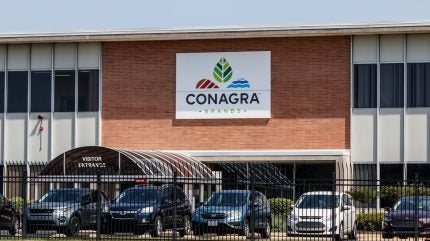
Conagra Brands has suggested further pricing could be in store as a counter to any inflationary undertones from Trump’s tariffs on international imports.
The frozen foods and snacks maker is one of the first major US CPG companies to comment on the potential post-tariff impact as CEO Sean Connolly discussed third-quarter results with analysts yesterday (3 April) following the president’s announcement the previous afternoon.
Connolly faced a barrage of questions on the issue. While he said industry will have to wait for the “dust to settle”, he highlighted how Conagra was still dealing with elevated inflation levels that are higher this year than the business had anticipated.
Conagra’s input-cost inflation was put at 4% for the third quarter of the company’s current 2025 fiscal year, for instance.
“We are still monitoring inflation, tariffs, consumer sentiment and the need for pricing. So overall, it’s too early to give you an outlook at this juncture,” the Conagra chief told analysts as they pressed for some guidance for 2026.
Connolly went at length to explain: “I understand everybody on this call today is really eager to get some perspective on how is next year going to unfold but we’ve got to see where the dust settles on these external factors because that is the biggest variable we are dealing with right now.”

US Tariffs are shifting - will you react or anticipate?
Don’t let policy changes catch you off guard. Stay proactive with real-time data and expert analysis.
By GlobalDataHe added: “We’ve already been dealing with inflation that really has not abated. We’ve had record inflation over the last few years, we’ve still been in higher inflation this year than we expected when we went into the year, and now we’re looking at potential factors that could exacerbate that and what are the follow-on actions that we’re going to have to take.”
While Conagra sources most of its input ingredients locally in the US, Connolly said the business could face import inflation issues from things like chipotle, avocadoes, palm oil and tinplate steel used in cans.
From the tariff list published by the White House, Indonesia and Malaysia, the world’s largest exporters of palm oil, have been hit with export taxes to the US of 32% and 24%, respectively, for instance.
Chile and Colombia, meanwhile, large exporters of fresh fruits like avocadoes, were both lumped with the baseline tariff of 10%.
Looking for “stability”
Connolly stressed the fluidity of the ongoing situation and the yet-to-be quantified potential impact on businesses from the tariffs but one aspect he pointed to was the uncertainty.
“Today, maybe there is an issue on things like palm oil that wasn’t on the radar as squarely yesterday, so things are moving around,” he told the analyst call.
“I’m not going to give you a definitive list right now because of the volatility of the situation. But as you know, running a business, you have to be able to have some stability in your assumptions. And right now, the assumptions that we’re making are moving around a bit.
“We’re tracking them by the minute. And as soon as we kind of see the dust settle, we’ll rack it all up, give you our outlook and that will be when we’re in a position to give you the best guide for the coming year.”
We’re going to have a number of levers available to us that we typically push on
Conagra CEO Sean Connolly
Pricing would be one option open to Conagra if tariffs prove to be inflationary. The business could absorb the extra costs itself or past them on to the consumer with the inherent risk to volumes and profit margins.
With respect to what Connolly termed “external factors”, he said: “We’re going to have a number of levers available to us that we typically push on. We’ll look at our productivity programmes and can we squeeze more out of that. We’ll look at alternative suppliers.
“Can we get a better price elsewhere, and we’ll look at pricing. Everything is on the table.”
Rather than the US food industry continuing to emerge from the inflation-led pricing era of the past few years and the current phase of rebuilding volumes and margins, Connolly alluded to difficult times ahead.
“As we start to think about what’s coming next year, I think we’re in for another year where we’re going to have our hands full in terms of continuing to drive growth and continuing to drive margin expansion.
“If we see prices in food or elsewhere go up further, I think you’re going to see more trade-down behaviours. I think the first thing you’ll see is discretionary purchases will weaken, foodservice trends will weaken, and then within at-home eating, I think you’ll see a lot of that value-seeking behaviour.
“We’re very well positioned to compete in that environment.”



